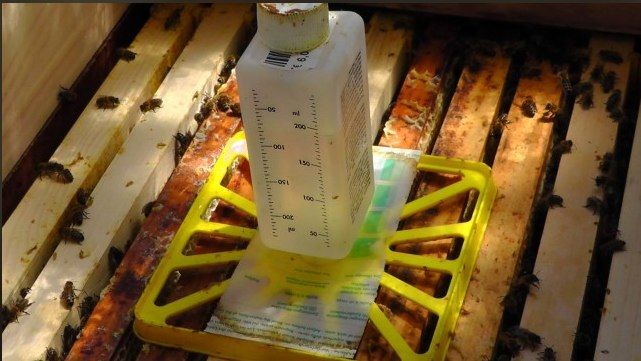I got the chance to try formic acid on one hive over the weekend. I used the method documented in the link I've posted above, a SARE grant project thru WVU.
http://www.wvu.edu/~agexten/varroa/FormicAcid.pdf
Instead of their fumigator, I used an inverted quilt box (about 2.5" high 8-frame box with #8 hardware cloth about 3/4" from the top). I laid several sheets of paper towel on that. I removed the honey supers, and put the quilt box/fumigator right above the upper brood box, and the telescoping top cover above that. A clean IPM board coated with veggie spray was placed under the SBB and the vents on the SBB were blocked off. I used the 3" entrance reducer. The hive was 3 8-frame deeps, heavily populated.
I mixed formic acid and water 50:50 (my hydrometer won't measure the target SG range so I just went by volume). I added HBH per their directions. This gives closer to 40% formic acid. The HBH supposedly reduces the chances that the bees will ball the queen in this stinky procedure.
The bees recoiled from the formic acid mix when it was first applied. They bearded heavily out the front entrance attempting to get away from it. Bearding was significantly reduced after 6 hours as the vapors dissipated. By the following morning they were looking a bit annoyed by the entrance reducer but had resumed normal activity.
After 24 hours I removed the IPM board for a count of the dropped mites, and removed the fumigator box and the entrance reducer and vent plugs.
A bit of background: the mite load of this hive was expected to be around 1% based on several powdered sugar rolls that returned 2-4 mites. But the hive has been producing weekly drops onto the IPM board as high as 191 mites. The discrepancy was making me doubt my sanity, but I was hoping the high drop was due to the "varroa sensitive hygenic" nature of the new queen introduced in June. We did, in fact, finally spot her, fat and sassy, just before the treatment.
The treatment is supposed to kill 80-90% of the mites. The first day of drop should be mostly from adult bees. Formic acid also kills mites in capped brood, so the high drop will continue for over a week. The paper shows 1-week drops from heavily infested hives of 4000 mites or more.
My 24-hour drop was 379 mites. Assuming that many more over the next week, total load was probably indeed around 1%, as the sugar rolls suggested
Six mites dropped into a dry oil tray while the count was going on. All were stone cold dead. Normally I'd have seen a few still crawling if dropped on a dry tray.
Smell: straight from the bottle, the 90% formic acid is powerful stuff, but a wiff is very similar to glacial acetic acid (distillate of vinegar). Diluted it is more tolerable but still strong. With the HBH it is still potent but better.
The main reason I'd think you would go for this treatment is the cost of the apparatus. OA requires a heated vaporizer. It is probably dandy once you have that, but for those of us with two hives, the cost of admission to FA is lower.
I reserve judgement until I find out of my hoity-toity VSH queen is still fat, sassy, barefoot, and pregnant and cranking out brood like she has all summer.






